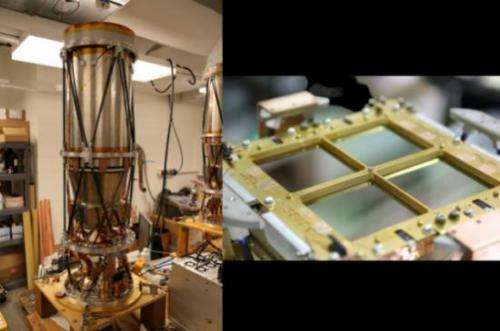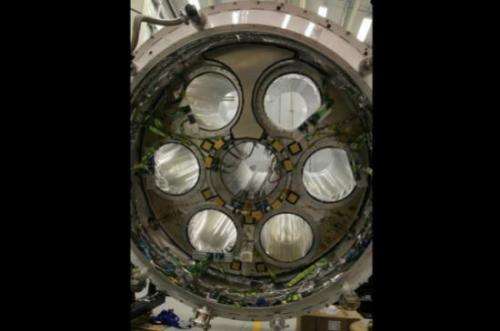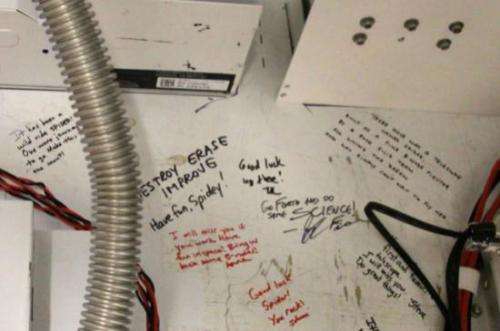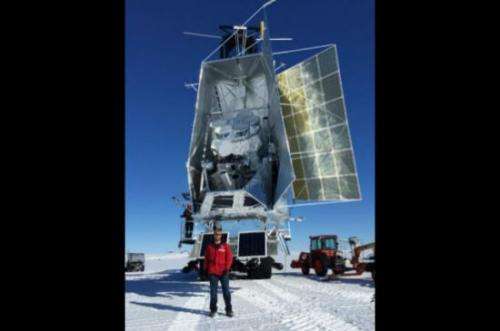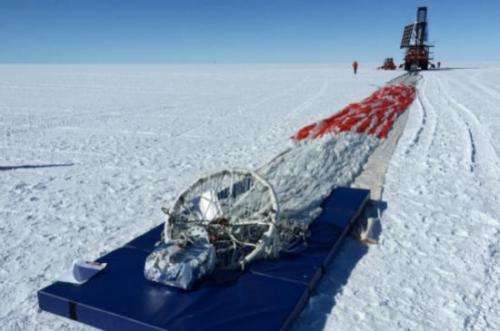Each of SPIDER's six telescopes (one shown here, at left, on a lab bench) includes a pair of lenses that focus light onto a focal plane (at right) made up of 2,400 superconducting detectors. Three of the telescopes measure at a frequency of 100GHz, while the other three measure at 150GHz.
After spending 16 days suspended from a giant helium balloon floating 115,000 feet above Antarctica, a scientific instrument dubbed SPIDER has landed in a remote region of the frozen continent. Conceived of and built by an international team of scientists, the instrument launched from McMurdo Station on New Year's Day. Caltech and JPL designed, fabricated, and tested the six refracting telescopes the instrument uses to map the thermal afterglow of the Big Bang, the cosmic microwave background (CMB). SPIDER's goal: to search the CMB for the signal of inflation, an explosive event that blew our observable universe up from a volume smaller than a single atom in the first fraction of an instant after its birth.
The instrument appears to have performed well during its flight, says Jamie Bock, head of the SPIDER receiver team at Caltech and JPL. "Of course, we won't know everything until we get the full data back as part of the instrument recovery."
Although SPIDER relayed limited data back to the team on the ground during flight, it stored the majority of its data on hard drives, which must be recovered from the landing site. The researchers carefully monitored the experiment's flight path, and when wind patterns suggested that the winds might carry the experiment over the ocean, they opted to bring SPIDER down a bit early. It touched down in West Antarctica, more than 1,000 miles from McMurdo Station.
Jeff Filippini, a former postdoctoral scholar at Caltech and member of the SPIDER team who is now an assistant professor at the University of Illinois, Urbana-Champaign, says the landing site is near a few outlying stations. "We are negotiating plans for recovering the data disks and payload," he says. "We are all looking forward to poring over the data."
The team originally proposed SPIDER to NASA in 2005. It is an ambitious instrument, and there were many technical challenges to getting it off the ground. Political challenges also played a role: in October 2013, after the team had completed full flight preparations in the summer and transported SPIDER to the Antarctic by boat, the U.S. government shut down, canceling all Antarctic balloon flights. SPIDER had to be shipped back to the United States.
Like bullets in a revolver, the six SPIDER telescopes slide into the instrument's cryostat (shown here without the telescopes). The cryostat is a large tank of liquid helium that cools SPIDER to temperatures near absolute zero so the thermal glow of the instrument itself does not overwhelm the faint signals they are trying to detect.
"But our team persevered," says Bock. "We used that extra time to make improvements and to fix a few problems. It is great to finally see all of our worries resolved and the hard work paying off."
A second SPIDER flight is planned for some time in the next two to three years, depending on how the hardware fares this time around.
-
Before SPIDER launched, many members of the team signed an out-of-the-way spot on the payload, wishing "Spidey" well and telling it to make them proud. Bill Jones, the project's principal investigator from Princeton University, also affixed a small photo of the late Andrew Lange.
-
Jeff Filippini, a postdoctoral scholar who worked on the SPIDER receiver team at Caltech, stands in front of the instrument as it was being readied for launch.
-
Prior to launch, the team laid out the parachute and hang lines in front of SPIDER, seen in the distance. The long-duration balloon that would carry SPIDER into the sky is attached to the end of the parachute shown here in the foreground.
Provided by California Institute of Technology
